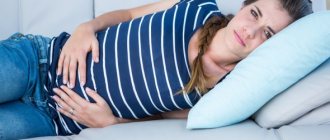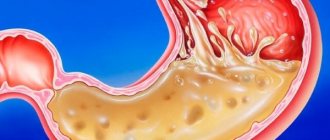Constipation: definition and types
Constipation refers to difficult or incomplete bowel movements and lack of regular bowel movements. In adults and children over one year old, defecation normally occurs daily, 1–2 times a day. In some cases, the frequency of bowel movements is considered normal once every 2 days, but subject to painless, free, complete and regular bowel movements. For children under one year old, the frequency of stool can vary widely - from 1 time per day to the passage of stool after each feeding. The nature of bowel movements and the density of stool in infants depends mainly on the type of feeding (natural, mixed or artificial).
The following conditions are considered signs of constipation:
- stool retention (no bowel movements for 48 hours or more);
- less than 3 bowel movements per week;
- passage of hard feces;
- pain or difficulty during bowel movements (need to strain);
- a feeling of incomplete bowel movement after passing stool.
There are acute and chronic constipation. Acute ones occur one-time and more often have a clear connection with provoking factors (inadequacies in nutrition, violation of the drinking regime). Chronic constipation worries the patient regularly, and this diagnosis is made if the symptoms of constipation persist for 3 months.
Up to contents
Special diet
If there is no urge to go to the toilet, everyone should know what to do. Following a diet and adjusting the diet are mandatory conditions for restoring normal bowel movements, especially with chronic constipation.
The daily menu should include foods rich in fiber (vegetables, fruits), as well as foods that have a laxative effect (bran bread, dried fruits, nuts). It is recommended to consume foods containing organic acids (citrus fruits, sauerkraut, fermented milk products). Fish oil is also useful. You need to drink about 2.5 liters of fluid per day.
Heavy and difficult to digest foods, foods low in fiber (flour products, rice, potatoes) should be excluded from the diet; foods that cause flatulence (legumes, sorrel, white cabbage) should not be consumed.
When there is no urge to go to the toilet, this may be a signal of a serious illness. Ignoring pathology or self-medication can lead to aggravation of the patient's condition. In some cases there is a risk of serious complications.
Causes
Constipation can be not only an independent disease, but also a symptom of a number of pathologies and conditions. The following are the main causes of constipation:
- Diseases of the gastrointestinal tract: chronic colitis, biliary dyskinesia, gastric ulcer, the presence of obstacles to the passage of feces (tumors, diverticula, etc.).
- Eating disorders: excess fatty foods, insufficient amount of coarse plant fiber in the diet, improper drinking regimen. Depending on the nature of the diet, constipation can be either acute (with single errors in the menu) or chronic.
- Low physical activity - intestinal motility and the speed of passage of feces through it depend on the general activity of the person. With a sedentary lifestyle, irregular bowel movements and difficulty defecating are much more common.
- Other reasons: pregnancy, psychological problems and stress (child entering kindergarten, school, etc.), high temperature (due to intense loss of fluid), taking certain medications, immaturity of the gastrointestinal tract in infants.
Up to contents
Oral medications
Medicines are used in the form of powders, tablets and syrups. Lactulose-based products are considered safe and can be used during pregnancy. They soften feces and facilitate their passage through the intestinal lumen. The effects of such drugs are mild, the effect appears 12 hours after administration.
The drug "Bisacodyl" is prescribed in tablets, but this drug has a number of contraindications; it is not allowed to be used by children and pregnant women.
Doctors also prescribe choleretic medications, the action of which is aimed at normalizing the digestive process and the act of bowel movement. Effective drugs include “Allohol”, “Hofitol”, and herbal mixtures.
To normalize digestion, it is recommended to take the drugs “Bioflor”, “Bifidumbacterin” and its analogues. These products provide the body with bacteria that activate the digestive process. They are used to treat patients after strict diets or during the postpartum period.
Treatment
Both chronic and acute constipation must be treated to alleviate your condition and avoid complications.
Proper use of laxatives
Regardless of the reasons, treatment of constipation with stool retention for 3 days or more requires preliminary cleansing of the intestines.
For this purpose, the following are most often used:
- laxatives,
- suppositories with glycerin,
- cleansing enemas.
What to do if you have severe constipation? Taking laxatives by mouth (oral) helps very slowly and unpredictably. Moreover, unpleasant side effects may occur, such as increased gas formation, rumbling and cramping abdominal pain. But some oral medications are well suited for the complex treatment of chronic conditions and the prevention of constipation.
The best option for cleansing the intestines during acute, including long-term and severe, stool retention is the drug MICROLAX®, produced in the form of microenemas. Compared to oral laxatives, it can take 5–15 minutes to work1. Other advantages of MICROLAX® include a high safety profile when following the instructions for medical use of the drug (it has no age restrictions or special contraindications) and a convenient release form - microenemas in individual single-use packaging. With the help of MICROLAX® it is very easy to get rid of constipation at home - administering a microenema does not require special skills. It is enough to simply insert the tip into the rectum, after squeezing out a drop of MICROLAX® to lubricate the tip (for a child under 3 years of age, insert the tip only halfway, up to the mark on it, or use MICROLAX® for children) and completely squeeze out the contents of the tube, then remove the tip , still lightly squeezing the tube.
Severe constipation is a common occurrence in hospital patients, especially those who have undergone surgery, and in pregnant women during their stay in the maternity hospital. Problems with bowel movements can also occur on the road (long train trips, business trips). In such situations, MICROLAX® can also help you - it can be used in the postoperative period and during pregnancy, and thanks to its convenient format it is very simple.
MICROLAX® has no restrictions on the duration of use and is suitable for the treatment of chronic constipation. In this case, a complex treatment therapy must be selected by a doctor.
Compliance with diet and drinking regime
To normalize stool, the use of laxatives alone is not enough. Nutrition is of great importance. Activation of intestinal motility, softening of feces and growth of beneficial microflora is promoted by dietary fiber: pectin, lactulose and coarse plant fiber. They are found in large quantities in fresh vegetables, fruits, berries, and grain shells (whole flour, bran, muesli).
Including fermented milk products in the diet - low in fat and fresh, additionally enriched with representatives of normal intestinal microflora (lacto-, bifidobacteria) - helps to get rid of constipation.
To normalize stools, it is imperative to increase fluid intake, in the form of bottled or boiled water.
Increasing physical activity
Regular exercises - gymnastics, swimming, running - contribute to timely cleansing of the intestines.
Solving psychological problems
Psychological problems and stress are common causes of constipation. For a young child, a change of environment, including entering a kindergarten or school, will be stressful. Children are often embarrassed to go to a public toilet and systematically hold back their stool. As a result, the feces become denser, the ampulla of the rectum expands, which leads to painful bowel movements, which is why the child is increasingly afraid to go to the toilet and a vicious circle is formed. Failure to treat this condition in children can lead to the development of serious complications in the future, such as stool, megacolon, rectocele, etc.
In case of constipation in adults, nervous overstrain and chronic stress also play an important role, therefore, in case of chronic problems with stool, the help of a psychologist and training in relaxation techniques would be useful.
Normalization of the daily routine
A normal daily routine is not only about adequate sleep and rest. This also includes achieving regular, daily (and preferably at the same time) bowel movements. The formation of a bowel rhythm is helped by the use of MICROLAX® in the initial stages of treatment - the use of a microenema in the morning helps to develop and strengthen the habit of going to the toilet at this time of the day.
Treatment of the underlying disease
If any disease is the cause of constipation, then to eliminate problems with stool, you must first begin treatment. In case of organic pathology (tumor, diverticula, congenital intestinal anomalies), surgical intervention may be required.
Up to contents
What to do if you are constipated
If you have functional constipation, the following recommendations can help you achieve normal bowel movements:
1) Lifestyle correction.
- There should be no morning rush; you need to set aside enough time to go to the toilet before school or work.
- Sometimes a hearty breakfast is a kind of stimulus for the appearance of stool. The generally accepted ideal time to go to the toilet is 15-30 minutes after breakfast.
- It is very important that you go to the toilet at the same time and regularly, this way we accustom the intestines to normal stool.
- Try to create conditions for a comfortable stay in the toilet, ask your relatives not to disturb you for a certain time, not to rush you.
- If the urge to defecate occurs during the day, do your best to go to the toilet.
2) Exercises to activate intestinal motility.
- Self-massage the abdomen with a circular motion of the palm in a clockwise direction before and during visiting the toilet.
- Before going to the toilet: imitate cycling, exercise the abdominal muscles (for example, inhale air, drawing in the stomach, and then “throw” the stomach forward as you exhale).
3) Nutrition correction. Eating regularly 3-4 times a day, consuming enough liquid (1.5-2 liters of drinks and liquid meals per day in the absence of contraindications), consuming enough fiber are important steps to normalize stool. It is known that residents of our country eat on average 16-18 g of fiber per day with a norm of up to 30-35 g, while in order to maintain this norm, you need to consume at least 400 g of fruits and vegetables per day.
In the absence of contraindications, it is preferable to consume vegetables and fruits raw, while in case of increased intestinal motility, heat treatment of vegetables (cooking, stewing) is mandatory.
Stimulation of stool can be facilitated by the consumption of fermented milk products, dried fruits, vegetable oil, honey (in the absence of contraindications), and the addition of coffee to the diet. By the way, drinking a glass of cool drink (water or juice) in the morning on an empty stomach often has a laxative effect. You can also use some mineral waters as recommended by your doctor. Since easily digestible carbohydrates slow down bowel movements, patients with constipation should limit white cereals (such as rice, semolina) and pasta.
In the modern world, where the Western type of diet predominates, with a large amount of refined foods and easily digestible carbohydrates, it is sometimes very difficult to maintain such a varied diet, so the high prevalence of constipation is not surprising. It is not for nothing that it is considered a disease of civilization. And by the way, another possible cause of constipation associated with modern civilization is the widespread use of toilets.
How are these related, you ask? Look: when sitting on the toilet, the pelvic muscles squeeze the rectum, making it difficult to empty. The most physiological way is to defecate while squatting (as people did at all times before), otherwise it is called the “eagle pose.” In this case, our hips and pelvis create an angle of approximately 35 degrees, there is no pressure on the rectum. However, we are people accustomed to convenience, and, of course, we will not refuse toilets. Therefore, you can use an alternative technique to create the desired body position - using a low footrest next to the toilet. This will automatically lift your legs and create the desired angle.
Constipation in children
If a child experiences constipation, especially chronic constipation, treatment should never be delayed. Prolonged bowel retention only aggravates the problem. The feces become dense and damage the intestinal mucosa, which leads to painful bowel movements - as a result, the child endures and deliberately avoids going to the toilet. Accumulating feces stretch the ampulla of the rectum, and encopresis (fecal incontinence) may subsequently form.
Parents are often interested in what to do if a child is constipated at 1 or 2 years old. The situation with stool retention in a newborn, one-month-old baby or infant becomes even more difficult for mothers and fathers. Young children are scared to use laxatives, especially since many of them are contraindicated at an early age.
To eliminate acute stool retention in a child from the neonatal period, MICROLAX® can be used: it has no age restrictions, and is also approved for infants. If constipation occurs, therapy should be supplemented with other measures - diet, increased fluid intake, increased physical activity.
For newborns and infants who receive only mother's milk, the diet must be followed by a nursing woman. When feeding with formulas, it is recommended to use special nutrition. Infants over 4 months of age need to introduce vegetable and fruit complementary foods in a timely manner.
Up to contents
Complications resulting from intestinal atony
Stool retention and incomplete defecation for a long period lead to serious dysfunction of organs and systems. Often this condition causes the development of recurrent colitis or damage to the final zone of the gastrointestinal tract.
The absence of defecation also leads to digestive disorders and the occurrence of enteritis as a result of the throwing of solid intestinal mass into the cavity of the cecum. The clinical picture can be complicated by hepatitis, problems with the biliary tract and rectum, and the appearance of neoplasms in the gastrointestinal tract.
Constipation in pregnant and lactating women
Due to hormonal changes in the body of pregnant women, as well as against the background of compression of intestinal loops by the growing fetus during the period of bearing a child, and then during feeding, constipation often appears.
Meanwhile, many laxatives are contraindicated for pregnant and lactating women. Changing your diet and increasing physical activity (within permitted limits) also do not always give a positive result.
For treatment at home and during a stay in the maternity hospital, pregnant women can use MICROLAX®, which is suitable for both the expectant mother and the child. It can be used for a long time, so it is also suitable for combating chronic constipation in pregnant women.
Up to contents
Irregular bowel movements
It all starts with irregular bowel movements. To understand what irregular stool is, let’s go backwards and define what regular stool is. It is considered normal when bowel movement occurs at least once a day1. According to modern physiology, only 8% of healthy people have stool less than once a day. Thus, 92% of practically healthy people have stool at least once a day1.
The frequency of bowel movements is influenced by the amount of fluid consumed and the type of food. The use of refined, purified, ready-made factory products provides the digestive system with only easy-to-digest substances and little fiber. As a result, bowel movements may become less frequent than usual.
Separately, it is necessary to highlight the problem of irregular bowel movements during pregnancy. Less frequent trips to the toilet may be associated with physiological changes in the body. Hormones that promote a relaxed state of the uterine muscles and maintain pregnancy can cause a decrease in intestinal muscle tone4. In late pregnancy, mechanical compression of the intestine may occur4. Irregular bowel movements may persist after childbirth. Since the work of a woman’s entire body is aimed at bearing and giving birth to a healthy child, other body functions may suffer for the sake of this goal.










